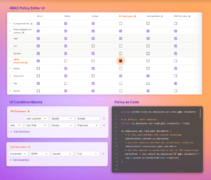Low-Code / No-Code Development explained
Low-code or no-code development is a modern implementation of the concepts of rapid application development that crystallized in the early 1990s. RAD tools, which auto-generated much of an application’s underlying code, really took hold when Agile development practices emerged and evolved a decade later. Today, low-code/no-code development is seen as a way to free up developers from doing mundane tasks so they can focus on innovative projects that will deliver bigger value to their organization. As the workforce gets younger, and those in product conceptualization and marketing come in with more knowledge of computing and programming, their desire to build their own solutions is accommodated by new RAD solutions. Low-code solutions can require some coding to complete a project, while no-code solutions are often custom solutions created for specific industries and vertical markets, so the visual component library holds exactly what is needed for applications in those spaces.
Low-Code Resources
The benefits of Low-Code Low-code and no-code tooling has become increasingly popular among developers and have a part to play in several different workflows. Buyer's Guide to low-code platforms This 2022 Buyer's Guide is a definitive resource on the latest low-code platforms available Low Code Development Platforms A Low-code development platform (LCDPs) is software that provides an environment programmers use to create application software through graphical user interfaces and configuration instead of traditional computer programming.The tools being created for rapid development have drag-and-drop interfaces, enabling non-developers to build workflows and create the user interfaces for their applications without having to get IT involved. But these low-code/no-code solutions also benefit developers by providing a way to work quickly, with fewer hand-written errors, and to iterate more often to create applications the end users actually want. These are all part and parcel of a digital transformation of the organization, which puts the focus on business value. There are numerous software providers in this space, coming at it from different angles. Some have created tooling to speed development on their platforms, while others can be used to create applications across a range of platforms.
In the low-code era, codeless testing tools deliver the efficiency and profitability coded test automation can’t
The use of low code and no code gained traction in recent years as demand continues to rise for faster and more efficient application development. To keep pace with the influx of newly built applications, many IT leaders are investing in testing automation — a market that’s projected to show a compound annual growth rate of … continue reading
How to level up your low-code game
At the end of 2022, Gartner made the prediction that in 2023, low-code spending would increase by 20%. This may seem like a bold claim, considering that lately it seems that all organizations want to do is cut, cut, cut. But when you think about the promise of low-code, and being able to do more … continue reading
Low code spending to increase in 2023
In the current situation IT teams find themselves in, they are being forced to do more with even fewer resources. You’ve likely heard (or possibly been affected by) the swath of layoffs that have plagued the tech industry over the past several months. IT teams are expected to continue outputting great work, except now their … continue reading
SD Times Open-Source Project of the Week: ToolJet
ToolJet is an open-source, low-code application development platform for building and deploying business applications. Users can use it to build complicated front ends without any experience in React, CSS, or event HTML. They can also drag and drop over 35 built-in UI components for more complicated frontends. With ToolJet, developers can also verify the current … continue reading
The phases and stages of the no-code development life cycle
Software development is in the midst of the no-code revolution, democratizing the process for knowledge workers by allowing non-developers to build applications. However, this space is still new and sometimes overhyped. Understanding what no-code development really is — and what it isn’t — is key to realizing the expected benefits and successfully starting your company’s … continue reading
OutSystems expands low-code platform with cloud-native development offering
OutSystems is expanding its low-code platform with capabilities for cloud-native development in the new OutSystems Developer Cloud (ODC). ODC combines an architecture based on Kubernetes, Linux containers, microservices, and AWS native cloud services with CI/CD, enterprise-grade security, and the productivity of low-code. It utilizes AI-augmented development through AI Code Mentor, which helps contribute to productivity … continue reading
Low code doesn’t necessarily mean low security risks
Low-code has many benefits, and they’ve been widely discussed in a number of articles here on SD Times, but one area in which they don’t really have an edge is security. It’s not that low code is more risky than traditional code, but the same risks are there, Jeff Williams, co-founder and CTO of Contrast … continue reading
Permit.io launches low-code Attribute Based Access Control as alternative to RBAC
Permissions framework company Permit.io has announced the release of Attribute Based Access Control (ABAC). ABAC has low-code/no-code interfaces for building permissions into applications, which allows any team at a company to incorporate permissions, not just developers. According to the company, ABAC includes all elements required for enforcement, gating, auding, approval flows, impersonation, and automating API … continue reading
Think low-code is just for citizen developers? Think again
I’m a big believer in the power of low-code platforms to redefine who can create and how they work. And I believe that it can have a similarly transformative impact on professional developers. While low-code development has had varying reception and pushback from professional developers, the technology is clearly the future. According to Gartner, by … continue reading
Hopping on the low-code locomotive
Will enterprise developers go loco for low-code, or will the whole concept someday become a no-go? Until recently, analysts would lump low-code in with no-code and a host of tools offering some form of drag-and-drop ease that enables ‘citizen developers’ (meaning: non-developers) the means to deliver apps. But where should you start in thinking about … continue reading
Do low-code / no-code platforms pose a security risk?
Low-code and no-code technologies are growing in popularity, so much that Gartner is predicting that 65% of application development by 2024 will be done using these tools. And why wouldn’t it be? Low-code/no-code platforms address the increasing demand for customized IT solutions by letting those closest to the issue build the solution. These tools provide … continue reading
Value driven planning and low code platforms, DevOps Edition
Increasing customer expectations have pushed business innovation into the clouds. We live and work in a world where digital customers expect an always on, always upgraded and always personalized digital experience across a multitude of devices and channels. These increasing expectations are forcing companies to move their digital transformations further into the clouds. Over the … continue reading














